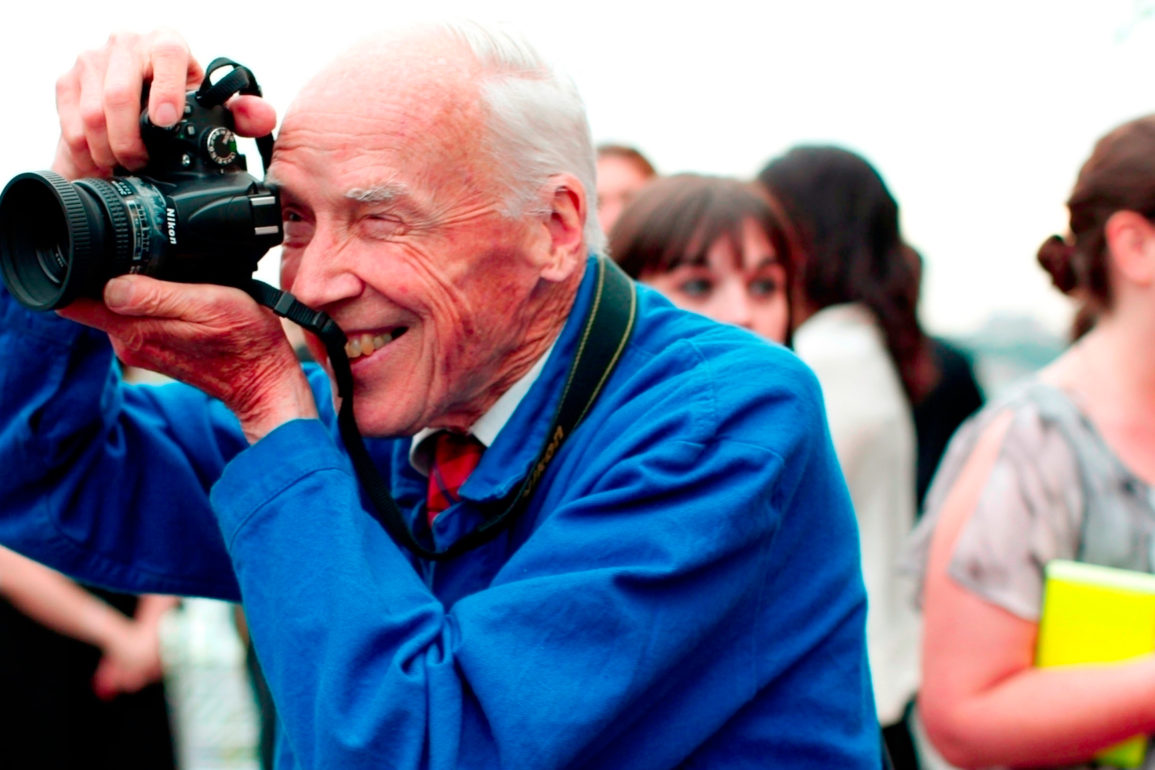Bill Cunningham, the beloved New York Times photographer who invented modern street photography, died Saturday in New York at 87, after a recent hospitalization for a stroke.
 Image Source: https://ello.co/giseleduprez/post/fgojs9tyeijgy_w-5ubzxw
Image Source: https://ello.co/giseleduprez/post/fgojs9tyeijgy_w-5ubzxwFittingly, the octogenarian photographer, who became an iconic New York landmark as he peddled around the city on his bike, clad in his signature blue French workers jacket, was working almost to the end.
As Jacob Bernstein noted in his obituary: “Nothing escaped his notice: not the fanny packs, not the Birkin bags, not the gingham shirts, not the fluorescent biker shorts.’’
Cunningham floated effortlessly between the world of high and low fashion, working his beat with trademark modesty, and insisting on not being taken in by the trappings of fashion. At the society events he frequently attended, he refused to accept a meal – or even a glass of water – lest it compromise his journalistic integrity.
 Image source: https://ello.co/ashlystohl/post/1yqx8ss36al6vtlqyg6ahq
Image source: https://ello.co/ashlystohl/post/1yqx8ss36al6vtlqyg6ahqWe were particularly honored when Cunningham appeared at Academy of Art University School of Fashion Graduate Show during New York Fashion Week back in 2008, and then more recently in 2014, photographing one of our celebrity instructors Ben Copperwheat.


Although known on the New York and European fashion scene for decades, Cunningham gained even greater fame after a documentary about him, “Bill Cunningham New York,” directed by Richard Press, was released in 2010.
The film, which Cunningham acceded to reluctantly and claimed never to have seen, shadowed him as he went to Paris to receive the Legion of Honor and chronicled his daily routine, painstakingly putting images for his column together and recording the popular video version of the column.

It also traced his eviction from the modest apartment above Carnegie Hall, decorated chiefly with filing cabinets of his photographs, where he had lived monastically for years.
“We all dress for Bill,’’ Vogue editor Anna Wintour famously allowed.
But everyone knew that he preferred to find the styles he liked on his own initiative, eschewing celebrity/paparazzi shots for the always surprising fashions of the street.
He had a flinty integrity, too.

The film recounts his horror when John Fairchild, the fabled publisher of Women’s Wear Daily, used his shots for one of his “In and Out’’ fashion victims spread. Cunningham was always too much of a gentleman to want to make fun of people.
He ultimately left WWD after a dispute with Fairchild over a dispute over whether Courreges or Yves Saint Laurent was a better designer. (Fairchild favored Saint Laurent, and Cunningham later conceded that he was right.)
 Image source: https://ello.co/ceciliemarie/post/taf8abrebvxgxe1qneg6pa
Image source: https://ello.co/ceciliemarie/post/taf8abrebvxgxe1qneg6paIn addition to his work for the Times, Cunningham was famous for his work for Details magazine, which gave him more editorial freedom. And he refused to accept payment for his work there. Asked why, he responded: “Money’s the cheapest thing. Liberty and freedom is the most expensive.”
He reportedly got hired by the Times after a higher-up saw a chance shot he’d taken of the reclusive actress Greta Garbo and only accepted a staff position there after he had a bike accident and realized he needed health insurance.
As Vanessa Friedman, the newspaper’s chief fashion critic, put it in her appreciation, Cunningham never saw himself as a fashion industry insider, even though people in that world craved the chance to appear in his columns.
“He began his career as a reporter… and his photographs were simply another expression of the same discipline,” she wrote. “They weren’t filtered, airbrushed or staged.”
 Image source: https://ello.co/spoonmagazine/post/m2fpkb0vaxcyxz0uxms_sa
Image source: https://ello.co/spoonmagazine/post/m2fpkb0vaxcyxz0uxms_saOne of Cunningham’s revolutionary contributions was that he was “among the first to recognize the value of observing what people wore in their everyday life,” Friedman added. “Before there was Scott Schuman, a.k.a. “The Sartorialist,” or Tommy Ton, or Phil Oh, there was Bill, riding his bicycle, reporting on what he saw: the idiosyncratic and the ubiquitous, but above all, the honest.”
He was one of a kind, who will be missed by everyone who knew him or was familiar with his work.
But he will never be replaced.



